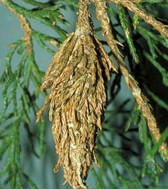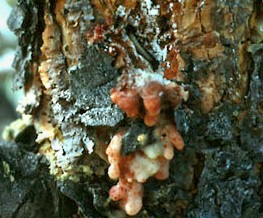Insects
The midwest has many types of insects that cause harm to your trees and shrubs. Some of these insects are nothing more than a nuisance, others are benifical. However, there are several types that do great damage to trees and shrubs and need to be addressed. The following list is a small portion of the insects that we face in our area. We will update this from time to time.

BORERS
Facts about borers
Shade tree borers are insects that develop underneath the bark of trees and shrubs.
Certain beetles and moths are the most common borers.
Most shade tree borers can successfully attack only trees that are injured or stressed.
Shade tree borer development takes from one to three years to complete. Adult stages of these insects occur outside the tree.
Control of shade tree borers includes maintaining growth and vigor of the tree or shrub.
Insecticides can best control shade tree borers if they are applied at the correct time. Sprays and injections work well on most borers in our area.
Emerald ash borer (EAB)
Emerald ash borer (EAB), Agrilus planipennis Fairmaire, is an exotic beetle that was discovered in southeastern Michigan near Detroit in the summer of 2002. This insect is devastating Ash trees in Michigan, Ohio and Indiana. The Emerald ash borer has not been discovered in Nebraska so far. In many areas the Emerald Ash borer was brought in on firewood from out of state, it can go undetected for several years. We are unsure when it will make it to our area. We are monitoring control methods. There are several treatments being used to try and control the problem. Some of these are currently used to control borers in our area. We will keep you informed as to this insects progress and what your options are when it arrives.
Bagworms

The past several seasons we have experienced increasing numbers of bagworms. The bagworm is a perennial insect pest of arborvitae, juniper, pine, spruce, and many other evergreen species. It also attacks certain deciduous trees such as black locust, honeylocust, and sycamore.
Bagworms first appear in late May or early June. They are easily controlled by spraying an insecticide. However, it has been our experience that the hatching period is not always uniform around the area. Therefore, we have a two spray program to combat this pest in mid June and early July. If your trees become infested, bagworms can destroy your evergreens.
Zimmerman Pine Moth

ZPM causes the greatest damage to Scots and Austrian pines. Infestation is determined by the presence of resin or pitch masses on the tree trunks where the larvae are feeding beneath the bark. Fresh pitch masses where the larvae are active will be white, soft, and shiny. Pitch masses from earlier generations will be hard, gray, and dull. Spraying the trunk of the pine tree in April and again in August should control this pest.
Facts about borers
Shade tree borers are insects that develop underneath the bark of trees and shrubs.
Certain beetles and moths are the most common borers.
Most shade tree borers can successfully attack only trees that are injured or stressed.
Shade tree borer development takes from one to three years to complete. Adult stages of these insects occur outside the tree.
Control of shade tree borers includes maintaining growth and vigor of the tree or shrub.
Insecticides can best control shade tree borers if they are applied at the correct time. Sprays and injections work well on most borers in our area.
Emerald ash borer (EAB)
Emerald ash borer (EAB), Agrilus planipennis Fairmaire, is an exotic beetle that was discovered in southeastern Michigan near Detroit in the summer of 2002. This insect is devastating Ash trees in Michigan, Ohio and Indiana. The Emerald ash borer has not been discovered in Nebraska so far. In many areas the Emerald Ash borer was brought in on firewood from out of state, it can go undetected for several years. We are unsure when it will make it to our area. We are monitoring control methods. There are several treatments being used to try and control the problem. Some of these are currently used to control borers in our area. We will keep you informed as to this insects progress and what your options are when it arrives.
Bagworms

The past several seasons we have experienced increasing numbers of bagworms. The bagworm is a perennial insect pest of arborvitae, juniper, pine, spruce, and many other evergreen species. It also attacks certain deciduous trees such as black locust, honeylocust, and sycamore.
Bagworms first appear in late May or early June. They are easily controlled by spraying an insecticide. However, it has been our experience that the hatching period is not always uniform around the area. Therefore, we have a two spray program to combat this pest in mid June and early July. If your trees become infested, bagworms can destroy your evergreens.
Zimmerman Pine Moth

ZPM causes the greatest damage to Scots and Austrian pines. Infestation is determined by the presence of resin or pitch masses on the tree trunks where the larvae are feeding beneath the bark. Fresh pitch masses where the larvae are active will be white, soft, and shiny. Pitch masses from earlier generations will be hard, gray, and dull. Spraying the trunk of the pine tree in April and again in August should control this pest.
|
SCALE INSECTS
 Scale insects cause damage by removing vital plant fluids from their hosts using their sucking mouth parts. Leaf and needle stunting and yellowing, twig and branch dieback as well as plant death are possible depending on population levels. In some instances, scales weaken plants making them susceptible to damage from secondary pests such as borers or environmental extremes, which may ultimately kill the plant. Scales can also create nuisance problems by producing a sticky, sweet substance called honeydew, which they secrete while feeding. The stickiness and associated black sooty mold that grows on the honeydew can be an annoyance if cars, patio furniture, decks, etc., are underneath scale-infested trees. We have noticed a rise in the amount of scale infesting trees and shrubs. There are several types of scale and a variety of trees that are hosts. We have noticed large amounts of scale on Maples, Oaks, Pines, Spruce, Birch, Linden and Aspen trees. Treatment of scale can be in the form of sprays or injections. The timing of applications are crucial to gaining control of scale. |
Insect Pests | Continue | Privacy Policy | Commercial Accounts